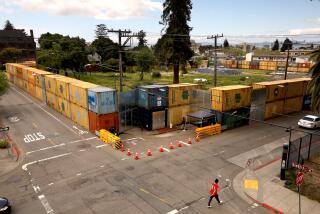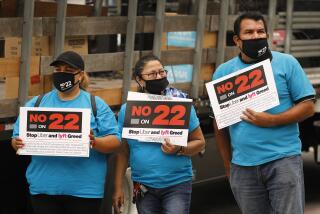Slow-Growth Statute Held Unconstitutional : Judge Strikes Down San Juan Capistrano Law, Ruling That It Puts Unfair Burden on Builders
- Share via
An Orange County judge Tuesday struck down as unconstitutional a slow-growth measure approved by San Juan Capistrano voters that would have banned any major new developments in the city until existing public works needs are met.
Superior Court Judge William F. McDonald found that the city’s Measure X placed an unfair burden on future developers to solve problems with traffic, sewer and other public works facilities caused by previous developments. The initiative was narrowly approved by city voters last November after a nearly identical countywide plan failed at the ballot box last June.
Second Legal Setback
McDonald’s decision dealt Orange County slow-growth advocates their second major legal setback in recent months. Last October, a judge rejected a similar San Clemente ordinance that also was approved by voters.
“This means that the slow-growthers will finally have to recognize the limitations that the Constitution and state law put on their ability to restrain development,” said Jeffrey Thomas, an attorney representing one of two developers who joined with the Building Industry Assn. to fight the initiative.
Leaders of the slow-growth movement, frustrated by what they contend was the judge’s misinterpretation of the ordinance, said Tuesday that they now will be forced to seek new options for slowing development. Among those options, they said, could be case-by-case public referendums on major projects.
“This is frustrating, but we’re not going to be set back by mere legal technicalities,” said Thomas C. Rogers, an architect of the countywide slow-growth measure and president of Citizens for Slow Growth and Traffic Control. “We just go back to the drawing board.”
San Juan Capistrano officials, who found themselves legally bound to defend in court a measure that they have criticized, said they had expected the initiative to be overruled. No decision was made Tuesday on a possible appeal.
“I’m personally glad that Measure X has been dealt this blow because I don’t think it would have done the city any good,” Mayor Gary L. Hausdorfer said. “It did nothing to really manage the volume of growth.”
By a margin of just 3 percentage points, voters in San Juan Capistrano were among several local communities last November to approve slow-growth measures aimed at meeting current and future demands on roads, sewers, parklands, police and fire protection, and other community resources.
Would Set Requirements
The San Juan Capistrano initiative would have required that a certain threshold of improvements to existing public works be met before any new developments could begin.
No funding mechanism for such improvements was spelled out in the measure. But building industry representatives have said that the measure would, in effect, have forced developers of future projects to assume much or all of the cost of these expensive improvements--even if they weren’t the ones who created the problem in the first place.
“It is not enough for the landowner to eliminate any negative impact of the development on these (public works) facilities” under the measure, attorneys for Kaiser Development Co. argued in opposing the plan. “He must also improve on the situation which existed before he began to develop his own land.”
But attorneys for the city, defending the measure before Judge McDonald in Santa Ana Tuesday, said they only want to see developers pay their “fair share” for placing increased demand on local resources.
Health and Safety Cited
“A local municipality historically has always had the right to control local development to protect health and safety,” attorney Daniel K. Spradlin, representing the city, told McDonald. He added that the measure “doesn’t impose the cost exclusively on the developers.”
But Judge McDonald asked Spradlin skeptically: “Isn’t (the developers’) fair share zero?” He said it was unreasonable to expect developers to pay for new roads and other improvements to meet already-existing needs.
McDonald, citing Superior Court Judge John C. Wooley’s rejection last October of San Clemente’s slow-growth initiative, called the San Juan Capistrano measure defective.
Mayor Hausdorfer said the decision now allows the city to review a backlog of about 50 proposed projects for compliance with earlier city ordinances regulating growth. The projects had been on hold after the voters’ November decision.
“I’m glad a decision has been made. Now we need to settle down and plan for the future because (the measure) has caused a great deal of confusion,” the mayor said.
Among the largest tracts for potential development may be those held by the firms that successfully blocked Measure X in court.
Kaiser Development holds title to the 17-acre Rosan Ranch in the south end of the city, on a hilltop parallel to Camino Capistrano, while Verde San Juan Estates General Partnership owns four residential lots on Toyon Drive in the hills above Ortega Highway.
May Have to Narrow Sights
Slow-growth advocate Rogers said the second court defeat for a ballot initiative may force slow-growth forces to narrow their sights in future battles.
“As long as the Building Industry Assn. (an opponent of the initiative) insists on fighting this thing in court ad nauseum, then the citizens, to defend themselves, are going to have to look to a simpler solution,” he said.
Rogers said that may mean abandoning broad policy statements as sought in the ballot initiatives and, instead, putting specific development proposals to the voters. That was the case in Cypress, where voters last week rejected the proposed Cypress Downs project on the Los Alamitos Race Course grounds.
But Rogers predicted that Tuesday’s court defeat “will make us more determined than ever.”
Spradlin, the lawyer who represented the city in pushing to implement Measure X, agreed. “This decision is certainly a discouraging word, but it’s not the last word,” he predicted.
The intense demand on local roads, sewer systems and other public works, Spradlin said, “is not a problem that’s going to go away if we stick our heads in the sand.”
More to Read
Sign up for Essential California
The most important California stories and recommendations in your inbox every morning.
You may occasionally receive promotional content from the Los Angeles Times.










